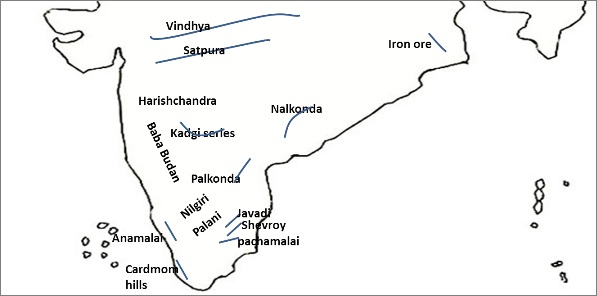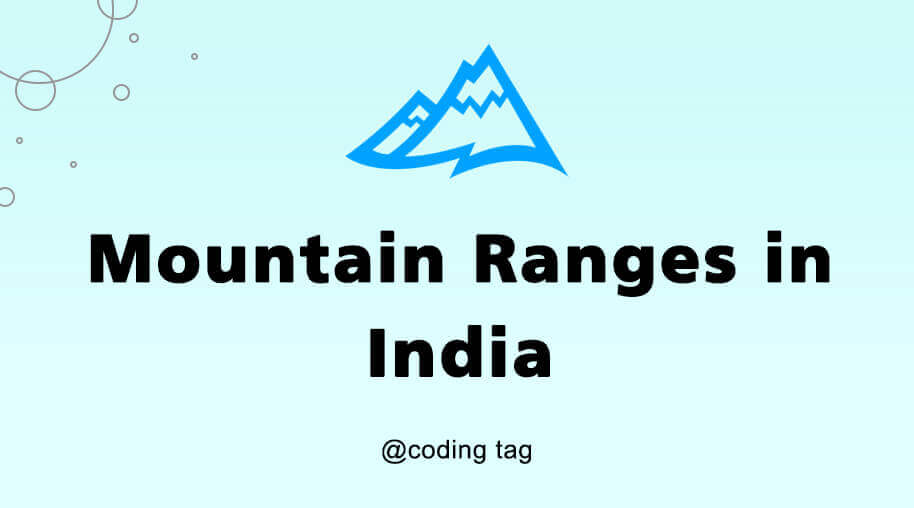Mountain Ranges in India
by Devender
0 1839
Northern India is ridden by the powerful pinnacle of the Himalayas. While southern India is encircled by Peninsular mountains that have very unpleasant and more established mountains in contrast with their northern partner. The Himalayas are the young fold mountains and are the highest mountain range of the world.
Mountain Ranges in India
1 Karakoram Range:
It is a subrange of the Hindu Kush Himalayan Range. The second highest peak in the world, K2 is located here.
- The border between India, Pakistan and China are formed by this range
- It is located in the regions of Gilgit-Baltistan (Pakistan), Ladakh (India), and the Xinjiang region (China)
- Famous glaciers here – Siachen Glacier, Biafo Glacier
- The Kailash Range is the extension of the Ladakh Range into China
- "LEH" India's cold desert lies here
- Its highest peak is Kamet (UK)
- The coldest place in India, Dras (the Gateway to Ladakh) is located in this region
- Shipki, Lipu Lekh (Lipulieke) and Mana Pass are some famous passes of this range
- Its highest point is Indrasan followed by Deo Tibba
- The Pir Panjal Railway Tunnel, the longest rail tunnel in India is located here
- Pir Panjal, Banihal and Rohtang Pass are some famous passes of this range
- Hanuman Ji ka Tiba otherwise known as White Mountain is the highest peak of this region
- It is about 2400 km long from Indus to the Brahmaputra
- It has a gap of about 90 km between the Teesta and Raidak rivers in Assam known as the sub Himalayas
- It means lines of peaks
- Guru Shikhar, Mt. Abu is the highest peak of this range
- Pipli Ghat and Hladi Ghat are the famous passes of this range
- Dhoopgarh is the highest peak of this range
- The caves having world-famous paintings of the Gupta period are located in this region
- These hills are made up of lava basaltic rocks
- These hills are bordered by Mishmi and Miri hills
- It is drained by the Dibang River, a tributary of the Brahmaputra
- Its northern and eastern parts touch China
- The Patkai-Bum
- The Garo-Khasi-Jaintia
- Lushai Hills
- The highest peak of this range is Sadbhawna Shikhar
- Dhupgarh is the highest peak of this range
- It acts as a water divide between Godavari and Krishna
- The Kolar mines are located here
- These hills are separated from the Karnataka plateau by the Moyar River
- And separated from the Anaimalai Hills and Palni Hills to the south by the Palghat Gap
- These hills are also known as the Blue Mountains
- These hills extend east into the plains of Tamil Nadu
- Its highest peak is Anamudi
- These are also known as Elephant Hills
2 Ladakh Range:
It is the Southeastern extension of the Karakoram Range lying from the mouth of the Shyok River in Ladakh to the border of Tibet.
3 Zaskar Range:
The Zaskar Range forms the boundary line between the Ladakh region of Kashmir and the remaining two regions of the state i.e. Jammu region and the Vale of Kashmir.
4 Pirpanjal Range:
It separates the Jammu hills to the south from the Kashmir Valley. The Great Himalayas lie beyond this range.
5 Dhauladhar Range (White Range):
It is home to major hill stations like Kullu, Manali and Shimla. It is spread in two major regions of India - J&K and Himachal Pradesh.
6 Shivalik Range:
The Shivalik Range is the southernmost and outer Himalayas also known as Manak Parbat in ancient times which means "tresses of Shiva".
7 Aravali Range:
It runs across Gujarat, Rajasthan, Haryana and Delhi. It is also known as Mewar Hills.
8 Maikal Range:
It is the eastern part of the Satpuras range of Madhya Pradesh.
9 Kaimur Range:
It lies parallel to the river Son and is the eastern portion of the Vindhya Range in MP, UP and Bihar.
10 Mahadeo Range:
This range forms the central part of the Satpura Range. It is located in Madhya Pradesh.
11 Ajanta Range:
It is located in Maharashtra, south of the Tapi River.
12 Rajmahal Hills:
It is the point of Ganges bifurcation and is located in Jharkhand.
13 Garo Khasi Jaintia Hills:
It is a continuous mountain range located in Meghalaya.
14 Mikir Hills:
It is a part of the Karbi Anglong Plateau and is located to the south of the Kaziranga National Park (Assam).
15 Abor Hills:
These are hills of Arunachal Pradesh located near the border with China.
16 Mishmi Hills:
These are situated at the junction of the Northwestern Himalaya and Indo-Burma ranges and are located in Arunachal Pradesh.
17 Patkai Range:
These are situated at the junction of the Northwestern Himalaya and Indo-Burma ranges and are located in Arunachal Pradesh. It consists of three major hills that are:
18 Mizo Hills (Lushai Hills):
These hills are a part of the Patkai range and are located in Mizoram and partially in Tripura.
19 Vindhya Range:
This range is a complex, discontinuous chain of mountain ridges, hill ranges, highlands and plateaus passing through Madhya Pradesh, Gujarat, Uttar Pradesh and Bihar.
20 Satpura Range:
It is a range of hills in central India passing through Madhya Pradesh, Gujarat, Maharashtra and Chhatisgarh.
21 Dalma Hills:
These hills are located in Jamshedpur and are famous for Dalma National Park and minerals like iron ore, manganese.
22 Girnar Hills:
These are located in Gujarat.
23 Baba Budan Giri:
These are located in Karnataka.

24 Harishchandra:
These hills are made of lava and are located in Pune.
25 Balaghat Range:
This range is located between MP and Maharashtra and is famous for manganese deposits.
26 Chilpi Series:
It is located in Madhya Pradesh.
27 Talcher Series:
Located in Orissa and is rich in bituminous coal.
28 Champion Series:
It is located in Karnataka, Dharawar period, and is rich in gold.
29 Nilgiri Hills:
These are a range of mountains in the western part of Tamil Nadu located at the junction of Karnataka and Kerala.
30 Palani Hills:
These hills are the eastward extension of the Western Ghats ranges and they adjoin the high Anamalai range on the west.
31 Anamalai Hills:
These are a range of mountains in the Western Ghats in Tamil Nadu and Kerala.
32 Cardmom Hills:
These hills are also a part of the Western Ghats in southeast Kerala and southwest Tamil Nadu.

33 Pachamalai Hills:
These are also known as the Pachais and are a part of the Eastern Ghats in Tamil Nadu.

Share:







Comments
Waiting for your comments